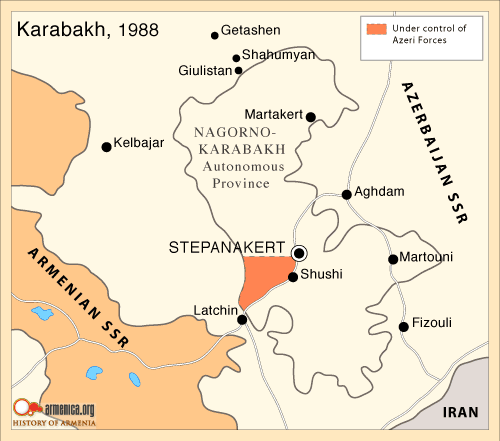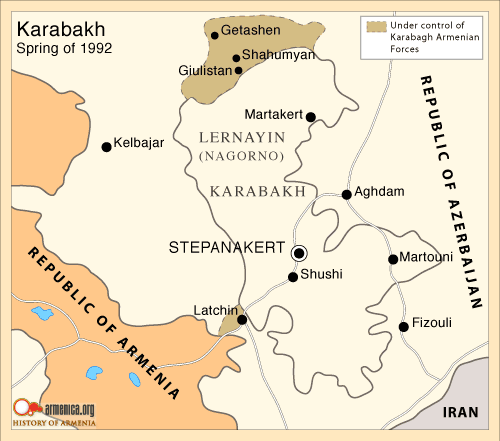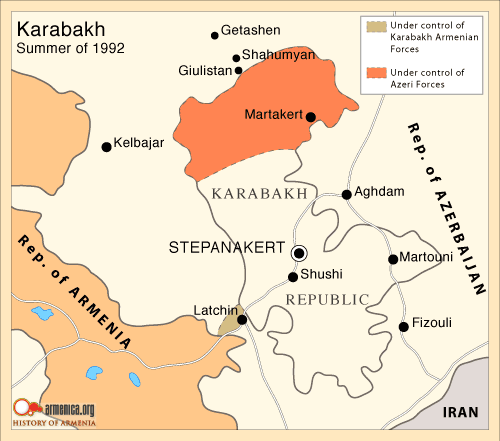1988:
February 11, 1988: Armenian activists organize public demonstrations in Stepanakert and other regional centers of Karabagh. Open letters, flyers, and petitions calling for reunification with Armenia are distributed during the rallies. Christian Science Monitor, 2/29/88
February 20, 1988: By a 110-17 vote, the Regional Soviet of the Nagorno-Karabagh Autonomous Oblast (NKAO) calls for the reunification of Karabagh with Armenia. Azerbaijani members of the Soviet abstain during the voting. Christian Science Monitor, 2/29/88
February 21-22, 1988: In Hadrut, Karabagh’s southernmost district, Armenian residents are attacked in retaliation for the recent public demonstrations. Many Armenians are driven from their homes toward Stepanakert.
February 23, 1988: The Central Committee of the Communist Party rejects the demands of NKAO. Massive demonstrations taken place in Yerevan, Armenia’s capitol.
February 27-29 1988: Azerbaijani mobs organize premeditated anti-Armenian pogroms in Sumgait, Azerbaijan, an industrial city on the shores of the Caspian Sea. Hundreds are killed. Nearly all of the remaining Armenian inhabitants hastily flee. United Press International, 2/29/88; New York Times, 3/1/88
March 4, 1998: Gangs of Azerbaijanis attack, beat, and kill Armenians in the streets of Kirovabad (Ganja). The number killed is unknown. Azerbaijani police do little to stop the violence. Toronto Star, 3/11/88
March 28, 1988: The USSR Supreme Soviet presidium rejects Nagorno-Karabagh’s call for reunification.
May 13, 1988: An Armenian child is killed when Azerbaijani gangs destroy an Armenian kindergarten in Stepanakert. United Press International, 3/13/88
June 15, 1988: The Supreme Soviet of the Armenian SSR adopts the decision taken during the NKAO’s February 20 session regarding reunification.
July 12, 1988: The NKAO Regional Soviet once again decides, in accordance with the provisions of the USSR Constitution, to secede from Azerbaijan. Macleans, 7/25/88
July 18, 1988: The USSR Supreme Soviet rejects NKAO’s call for reunification.
July 29, 1988: Half a million people rally at night in the Armenian capital of Yerevan to protest a Kremlin ruling dashing Armenian claims to Nagorno-Karabagh. Los Angeles Times, 8/3/88
September 18, 1988: One Armenian is killed and 70 others are wounded in disturbances in Khojalu, near Stepanakert. Economist, 9/24/88; Washington Post, 9/21/88

February 11, 1988: Armenian activists organize public demonstrations in Stepanakert and other regional centers of Karabagh. Open letters, flyers, and petitions calling for reunification with Armenia are distributed during the rallies. Christian Science Monitor, 2/29/88
February 20, 1988: By a 110-17 vote, the Regional Soviet of the Nagorno-Karabagh Autonomous Oblast (NKAO) calls for the reunification of Karabagh with Armenia. Azerbaijani members of the Soviet abstain during the voting. Christian Science Monitor, 2/29/88
February 21-22, 1988: In Hadrut, Karabagh’s southernmost district, Armenian residents are attacked in retaliation for the recent public demonstrations. Many Armenians are driven from their homes toward Stepanakert.
February 23, 1988: The Central Committee of the Communist Party rejects the demands of NKAO. Massive demonstrations taken place in Yerevan, Armenia’s capitol.
February 27-29 1988: Azerbaijani mobs organize premeditated anti-Armenian pogroms in Sumgait, Azerbaijan, an industrial city on the shores of the Caspian Sea. Hundreds are killed. Nearly all of the remaining Armenian inhabitants hastily flee. United Press International, 2/29/88; New York Times, 3/1/88
March 4, 1998: Gangs of Azerbaijanis attack, beat, and kill Armenians in the streets of Kirovabad (Ganja). The number killed is unknown. Azerbaijani police do little to stop the violence. Toronto Star, 3/11/88
March 28, 1988: The USSR Supreme Soviet presidium rejects Nagorno-Karabagh’s call for reunification.
May 13, 1988: An Armenian child is killed when Azerbaijani gangs destroy an Armenian kindergarten in Stepanakert. United Press International, 3/13/88
June 15, 1988: The Supreme Soviet of the Armenian SSR adopts the decision taken during the NKAO’s February 20 session regarding reunification.
July 12, 1988: The NKAO Regional Soviet once again decides, in accordance with the provisions of the USSR Constitution, to secede from Azerbaijan. Macleans, 7/25/88
July 18, 1988: The USSR Supreme Soviet rejects NKAO’s call for reunification.
July 29, 1988: Half a million people rally at night in the Armenian capital of Yerevan to protest a Kremlin ruling dashing Armenian claims to Nagorno-Karabagh. Los Angeles Times, 8/3/88
September 18, 1988: One Armenian is killed and 70 others are wounded in disturbances in Khojalu, near Stepanakert. Economist, 9/24/88; Washington Post, 9/21/88









Comment